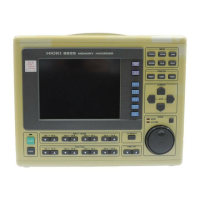ppendix 3 Reference
・The 8835-01 converts the input signal to a digital value, then carries out all
internal processing digitally. This process of converting an analog signal to
digital values is termed sampling.
・Sampling measures the magnitude of the signal at fixed time intervals
(sampling periods).
・The rate of taking these measurements is termed the sampling rate.
・The units are S/s, read as samples per second.
・This is the reciprocal of the sampling period (1/T).
・If the frequency of the signal being measured is significantly higher than the
sampling rate, it is possible for sampling to produce an apparent signal which
is actually nonexistent. This phenomenon is termed aliasing.
・When using the memory recorder function, because the sampling period for
the time axis range may vary widely, care should be taken in setting the
range not to produce aliasing.
・The measurement frequency limit is determined by the setting of the time axis
range. In any event, it is always best to use the highest practicable sampling rate.
・When measuring a repeating signal, using the auto ranging function is
another useful technique.

